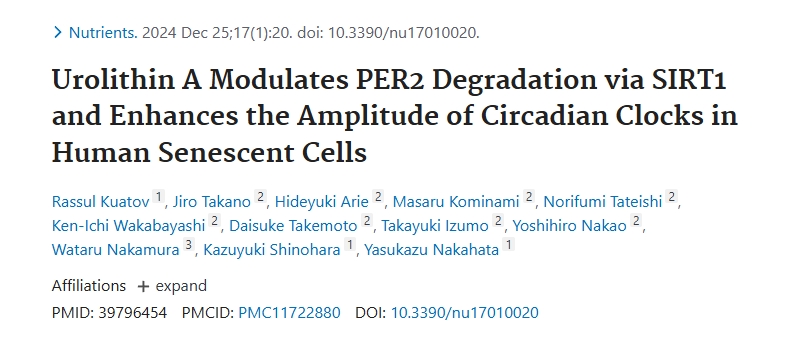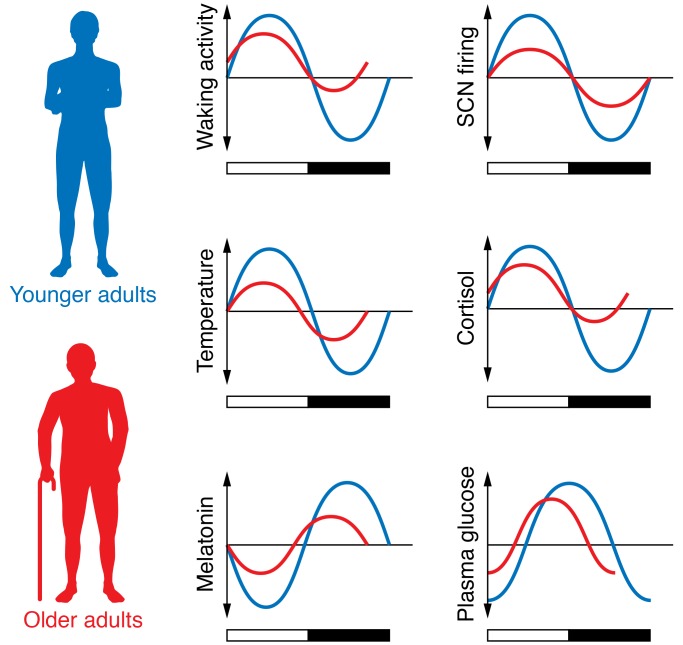Breakthrough discovery: how urolithin A resets the aging clock Nagasaki University unveils new mechanism for regulating biological rhythms
A research team from Nagasaki University has recently explored the effects of dietary polyphenolic compounds, particularly ellagic acid and its metabolites (such as urolithins A, B, and C), on the biological clock in senescent cells. The biological clock is an endogenous system that regulates various physiological and behavioral events in living organisms. As aging progresses, the precision and robustness of the biological clock decline, leading to extended oscillation periods and reduced amplitude of clock gene rhythms, which in turn contributes to aging and multiple health issues.

Rhythmic "Misalignment" in Aging: The Biological Clock’s "Timing Shift" and "Amplitude Attenuation"
The biological rhythm, as a core timing system of life, is governed by a central clock located in the suprachiasmatic nucleus (SCN) and a network of peripheral clocks distributed throughout the body, precisely coordinating the periodic expression of approximately 40% of genes. This molecular timing mechanism, based on a transcription-translation feedback loop (TTFL), involves core components such as the CLOCK/BMAL1 heterodimer and clock genes like Period (PER1/2/3) and Cryptochrome (CRY1/2). These gene products undergo phosphorylation modifications and subcellular localization changes, forming a self-sustaining oscillatory cycle of approximately 24 hours.
Recent studies have revealed a bidirectional regulatory relationship between biological rhythm systems and cellular aging. On the one hand, clock genes influence the aging process by regulating longevity-associated pathways such as SIRT1 and AMPK. On the other hand, oxidative stress and mitochondrial dysfunction associated with aging disrupt the oscillatory properties of clock genes. This vicious cycle leads to circadian disturbances commonly observed in elderly individuals, such as phase advances and amplitude attenuation. Research suggests that, compared to younger individuals, elderly individuals may experience sleep onset and wake-up times 1-2 hours earlier. This phase advance is not merely a behavioral change (such as going to bed earlier) but reflects intrinsic changes in the biological clock itself.
Beyond phase shifting, the "dampening" of rhythmic amplitude is another significant age-related change. This means that physiological indicators such as body temperature and hormone levels fluctuate less prominently. For instance, compared to younger individuals, elderly individuals exhibit a ~14% reduction in lipid circadian rhythm amplitude, a 50% decrease in melatonin secretion amplitude in individuals over 80 years old, and a ~0.3°C reduction in body temperature fluctuation. The weakening of circadian rhythms is believed to increase susceptibility to various age-related diseases, including diabetes, dyslipidemia, and neurodegenerative disorders.

Figure Caption: Compared to young individuals (blue line), many rhythmic amplitudes are weakened in elderly individuals (red line).
In some cases, the peak of rhythms also shifts forward. [Image source: DOI: 10.1172/JCI90328]
Molecular Decoupling of Biological Rhythms in Aging: Urolithin A Boosts Rhythmic Amplitude
The research team at Nagasaki University established a senescence model using TIG-3 cells, providing an ideal platform for analyzing aging-related circadian disruptions. Through real-time bioluminescence monitoring, researchers observed that the oscillatory amplitude of the Bmal1 gene in senescent cells decreased by 67%, while the period lengthened by 2.3 hours. This alteration closely mirrors the physiological rhythm attenuation observed in aging, validating the cellular model’s effectiveness in simulating the rhythmic phenotype of aging.
The study investigated the effects of ellagic acid (EA) and urolithin A (UA) on circadian clock gene expression patterns. Results showed that UA significantly enhanced the rhythmic amplitude of Bmal1 in senescent cells (by approximately 4 fold), with a similar effect observed in proliferative cells. This suggests that UA’s impact on circadian clock genes may extend beyond aging populations and be more widespread than previously anticipated. In contrast, EA exhibited no significant influence on circadian properties in either senescent or proliferative cells. Further research indicated that other metabolites of ellagic acid, urolithin B and urolithin C, also showed potential in enhancing circadian rhythmic amplitude, though their effects were weaker than that of UA.
Figure Caption: Metabolites of EA, rather than EA itself, exhibit potential in enhancing circadian rhythmic amplitude (Figure A),
with UA showing the most significant effect among the EA metabolites (Figure B).
To gain a deeper understanding of how UA enhances the amplitude of Bmal1 in senescent cells, the researchers, using a luciferase fusion protein detection system, found that UA treatment significantly reduced the stability of the Per2-luc protein (half-life shortened from 3h to 1.7h), suggesting that UA promotes the degradation of the Per2 protein. Since the stability of Per2 protein partly depends on its acetylation status, and SIRT1-mediated deacetylation of Per2 can promote its degradation through the ubiquitin-proteasome system. Considering that SIRT1 is a NAD+°-dependent deacetylase, the researchers further assessed whether UA increased NAD+ levels in senescent TIG-3 cells. Although UA did not alter intracellular NAD+ levels, there was a tendency for SIRT1 protein levels to increase after UA treatment, while SIRT1 mRNA levels decreased by 50%. These results suggest that UA may affect SIRT1 expression through post-transcriptional modification or protein stability regulation rather than direct transcriptional regulation.
Senescent cells accumulate with age in the human body, and the disrupted biorhythmic state of senescent cells is a major risk factor for aging-related diseases.The potential of UA to modulate the biorhythms of senescent cells may contribute to increasing the amplitude of a wide range of physiological events dominated by biorhythms, a property that makes UA a promising nutrient supplement that can ameliorate problems associated with biorhythmic dysfunction.
Dual Mechanism of Urolithin A in Reversing the Aging-Related Circadian Phenotype
Nagasaki University’s latest breakthrough reveals the unique rhythm-resynchronizing mechanism of urolithin A (UA). This study is the first to confirm that UA restores rhythmic oscillations in senescent cells through the dual pathways of the SIRT1-PER2 axis and chromatin remodeling.
On a molecular level, UA treatment shortened the half-life of Per2 protein from 3 hours to 1.7 hours, increasing its degradation rate by 76%. This effect was attributed to UA-induced stabilization of SIRT1 protein—despite a 50% reduction in SIRT1 mRNA levels, SIRT1 protein expression increased 1.8-fold, suggesting enhanced translation efficiency or reduced protein degradation.
More intriguingly, UA significantly improved chromatin accessibility in senescent cells. ATAC-seq analysis showed that UA treatment increased chromatin openness in the Bmal1 regulatory region by 3.2-fold, and the H3K27ac modification level at CLOCK protein binding sites increased by 2.7-fold. This epigenetic remodeling created a favorable environment for the periodic expression of clock genes.
Additionally, metabolomic analysis revealed that UA restored succinate levels in senescent cells (increased by 2.1-fold). Succinate, a key intermediate in the tricarboxylic acid cycle, has been shown to enhance circadian gene amplitude via the succinate receptor SUCNR1. This metabolic-epigenetic-rhythm regulatory network provides a novel explanation for UA’s multi-target effects.
Figure Caption: Mechanistically, UA may stabilize SIRT1 protein, enhance its deacetylation activity, thereby promoting PER2 deacetylation
and degradation, ultimately suppressing CLOCK/BMAL1 activity and enhancing Bmal1 rhythmic expression.
Urolithin A and Circadian Regulation: A Potential "Dark Horse" for Boosting Daytime Energy?
Many aspects of human physiology are regulated by the biological clock, an endogenous timekeeping system that produces 24-hour rhythms not only in the sleep-wake cycle, but also in other bodily functions, such as hormone levels, metabolism, and immune function. This new result on UA shows us the potential of UA to reverse the rhythmic phenotype of aging by regulating the amplitude of rhythmic genes.
Previous studies have shown that the presence of oak extract (which is metabolized to EA and urolithin) in the diet of aged mice increased the daily activity/rest ratio, which was not observed in young mice. Indications of UA's role in the regulation of rhythms may imply that UA enhances the rhythmicity of a wide range of physiological activities affected by circadian rhythms, such as metabolism, sleep-wake cycles, and daytime energetic vigor. With the deeper understanding of the mechanism of action of UA in scientific research, this natural compound may become one of the nutritional strategies to optimize the biological clock and enhance the quality of life.
Of interest, ellagic acid, the parent compound of UA, is widely available in foods such as pomegranate and walnuts, but there are significant individual differences (0-50%) in conversion efficiency in humans. This suggests that personalized supplementation strategies or optimization of UA bioavailability through microbiome engineering may be required in the future.
Moreover, most of the current studies on the regulation of biological rhythms by urolithin A have been focused on the cellular and animal experiment levels. Although these studies have yielded a number of valuable results, the results of cell and animal experiments are not fully equivalent to the actual situation in humans. Therefore, there is an urgent need for more companies and research institutions to increase investment and actively carry out human clinical studies to comprehensively and thoroughly verify the safety and efficacy of urolithin A. Only through rigorous human clinical research can we clarify the mechanism of urolithin A in the human body, the appropriate dose and possible side effects, to provide a solid and reliable scientific basis for its future application in the field of medical treatment, health care and other areas.
Reference
Kuatov, Rassul et al. “Urolithin A Modulates PER2 Degradation via SIRT1 and Enhances the Amplitude of Circadian Clocks in Human Senescent Cells.” Nutrients vol. 17,1 20. 25 Dec. 2024, doi:10.3390/nu17010020
Disclaimer *
The information available on this site is solely for the purpose of providing general knowledge. All information, including any text, expression or statement, is intended for business-to-business customers only and not intended for end-use consumers.
News & Blog
Related Ingredients








